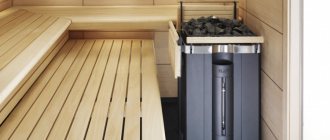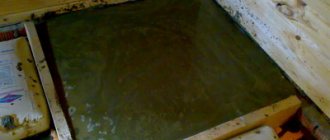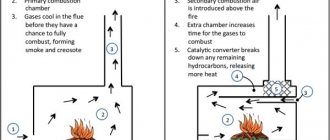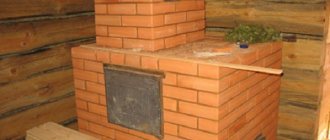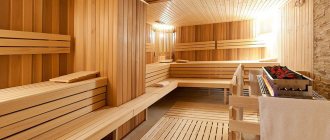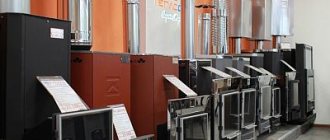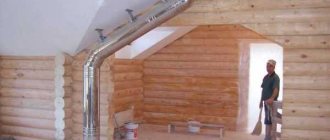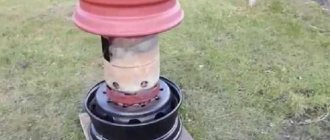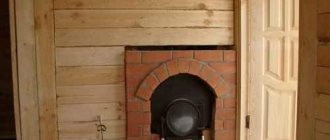Under no circumstances can a sauna be complete without a stove, but how much of the sauna space will it take up? The question is far from idle, even if you are not going to design stoves yourself. With purchased stoves, everything is more or less clear - just look at the product catalogs of the company you are interested in, where the dimensions are usually indicated. However, we decided to make your task easier and give the dimensions of the most popular metal stoves . Brick kilns come in different designs, but they are made proportional to the parameters of the bricks used.
Types of structures
They differ in structure and operating principles. Let's look at each type in more detail.
Open
The stones are laid on top of the stove structure and are not covered with anything. Due to this, the steam room warms up faster, reaching temperatures of up to 100 degrees. But the humidity in the room is low, so the heat turns out dry.
The product consists of three parts:
- fireboxes;
- compartments for stones;
- containers with water.
There should be few stones, otherwise the top layer will not warm up well and the steam room will not be warm enough.
To increase the level of humidity and the release of water vapor, the hot stones are simply watered. One or two ladles will be enough - this will give up to 15% humidity.
To increase the level of fire safety and reduce the risk of burns, it is recommended to lay fire-resistant bricks around the walls of the furnace or make a partition made of wood.
To heat a sauna, it is important that as much of the stove area as possible is in contact with the air space. This contributes to faster heating of the air in the steam room
Closed (lined with brick or stone)
If wood fuel is chosen for heating, you will have to prepare large reserves in advance. Such a stove takes a long time to reach the desired temperature, but, having reached the desired level, gives good heat transfer and retains heat for a long time.
Closed structures are great for large baths, where there is not only a steam room, a wash room, a dressing room, but also a relaxation room.
One of the advantages is closed stones. Therefore, there is no risk of getting burned.
In factory economical models, the stove has a double casing with a gap for air exchange between the walls.
Combined
For most manufacturers, the design consists of a high box with gratings and double valves (performs the function of a firebox). A chimney pipe emerges from the neck of the box. Stones are placed in the neck here.
There are devices available for sale with combined fuel types:
- gas-wood;
- electric wood-burning.
They do not need to be constantly monitored. Simply adjust to the desired temperature.
By design they are divided into 3 types:
- Monoblock. With heat exchanger, combustion chamber. Gas burner of a fixed type, covered with a steel sheet.
- Paired. They have two separate combustion chambers for wood and gas.
- Reconfigurable. Universal device. Can be modified for each fuel.
The first two types do not need to be reconfigured, since you can switch from one type of fuel to another.
Gas is used as main gas or liquefied in cylinders.
The electric-wood-burning design allows you to successfully heat the bathhouse using electricity or wood (optional). Moreover, firewood is considered the main raw material. When they burn out and the temperature drops, the electric heater automatically starts working. There are two heating elements on the sides of the product. Such stoves operate on a 220 W network, with a three-phase voltage of 380 V.
The owners can choose which fuel to heat the bathhouse with. But such designs are many times more expensive than simple wood-burning stoves.
Model range overview
offers customers several lines of bath stoves with some modification features:
Russian steam - durable units made of cast iron with an open or closed heater. The stoves operate in Russian bath mode, the steam is fine, dry and transparent.
President (Hurricane, Legend) - models with a cast-iron firebox, an enlarged heater grid and a closed heater module.
Rusich - made of especially durable boiler steel grade 09G2S 6-8 mm. The thickness of the top of the combustion chamber and the rear wall of the furnace has been increased to 8 mm, since these areas are the most thermally loaded.
Skiff - made of structural steel up to 8mm thick and has a minimum of welds. High-strength cast iron parts are used in areas exposed to high temperatures.
Classic is a classic stove with an open heater and a remote tunnel of increased length for simultaneous heating of the steam room and adjacent rooms. On the side of the rest room, the model is equipped with a large cast-iron door with glass.
Premium – elite and expensive stoves lined with natural stone.
Elite – models with an external tunnel designed for heating the steam room and adjacent rooms. On the firebox side, the stoves are equipped with a large fireplace door with glass.
Sensation - cast iron firebox with convector casing. This stove has a small heater, but will warm up the bathhouse faster.
Vertical - a type of units with an open heater, equipped with an additional chamber for burning previously generated gases that appear during smoldering fuel, double flame circulation technology has been introduced.
Sanduns are models with a cast iron firebox and a barrel-shaped heater, closed by a stainless steel heater and a funnel for supplying water to the closed heater. Conceptually, it is somewhat similar to the Geyser and Barrel furnaces from TMF, only made of cast iron.
In addition to high technological characteristics, all Vesuvius brand furnaces have an aesthetic appearance. The design of the body can be selected to suit any interior and style of bath or sauna.
Electric furnace power calculation
When using a firebox with a tubular heating element, the following values are taken as standard: per 1 m3 of room, 1 kW of equipment power is required. 2 kW is added to the resulting amount to obtain a power reserve or 2 kW is subtracted if you need to save on the purchase. It should be noted that it is not advisable to take more than 2 kW, since the stove will not cope with heating the steam room. Thus, for a room with a volume of 10 m3, it is enough to choose an 8-12 kW electric furnace. Volume is calculated by multiplying 3 quantities: height, width, length of the walls.
It is necessary to take into account the losses of the firebox through the cracks of the front door (-1 kW) and insufficient insulation of the walls
That is why it is important to choose the right insulation and calculate its thickness. It is also necessary to ensure good ventilation in the steam room.
It should provide a flow of fresh air for a comfortable stay, but not overcool the room. In addition, ventilation ensures a quick release of steam after finishing using the bathhouse, which is important for drying the walls and preventing the appearance of mold and mildew.
Varieties
Brick
A brick (or stone) stove is a classic of bathhouse buildings, but its construction requires certain experience and skills, compliance with safety regulations, knowledge of the technology for ensuring good traction and other important nuances, without which the proper functioning of the stoves is impossible. In addition, a stone structure requires sufficient space in the room, the creation of a separate foundation, and special compliance with fire safety rules.
Metal
Today, the most economical option is metal sauna stoves, which have a number of undeniable advantages.
- Economical. The metal stove is compact, its installation does not take much time and space.
- Huge selection of options. It is possible to choose a model suitable for a specific bath.
- Ease of installation. In order to install a ready-made metal stove, no stove making skills are required.
- Due to its compactness, a metal stove can be covered with a heater. This way it will keep warm for a long time and look like a classic sauna stove.
Calculation of a stove for a bath: required power and firebox volume
No one doubts that the size of a sauna stove somehow depends on the power - the larger it is, the more fuel needs to be burned, the larger the size of the firebox or the number of heating elements should be. It is also true that power is a derivative of the size of the room to be heated. Therefore, the larger the room, the larger the oven.
Therefore, the first thing to do correctly is to calculate the power of the unit that can bring your stove to the desired mode in winter and summer in a reasonable time.
IMPORTANT! In principle, if you heat even a low-power stove for a very long time, it will still be able to heat the room, but this option is not considered, since the timing will obviously be “unreasonable.” So, what is a “reasonable time frame”? A brick oven takes a long time to heat; it definitely won’t take less than 4 hours.
A metal one can handle it in half an hour to an hour (depending on the time of year and ambient temperature). That's how we'll count it somewhere
So, what is a “reasonable time frame”? A brick oven takes a long time to heat; it definitely won’t take less than 4 hours. A metal one can handle it in half an hour to an hour (depending on the time of year and ambient temperature). That's how we'll count it somewhere.
First, let’s establish what matters when heating:
- presence of thermal insulation on the walls;
- temperature outside the window.
For the initial calculation, you can also start from the volume of the room. Divide it by two - you get a very relative number of kilowatts required from the stove. Next is just multiplication, because you also need to heat the unit itself, the stones in it, someone needs to heat the water for the washing machine, and some of the heat produced will definitely fly away into the chimney. Therefore, we safely multiply the resulting kilowatts by 2.5-3. And this will be a figure that is true for a somewhat heat-insulated steam room that is not combined with a washing room.
If there is no thermal insulation, just a bare frame, multiply the total again - now by 1.5.
If your stove has to heat not only the steam room, but also the adjacent rooms, then skip the last step, return to the data of the penultimate multiplication and multiply it by 2. This power should be enough for the adjacent ones.
Attention! Unfortunately, it is worth recognizing that most calculations of this level are extremely approximate. However, without more precise coefficients, we will continue
Our task is to calculate the combustion volume of a wood-burning stove that would correspond to the required power. In principle, you can calculate the required number of heating elements yourself - it’s much easier, because the power of each heating element is known
However, without more precise odds, we will continue. Our task is to calculate the combustion volume of a wood-burning stove that would correspond to the required power. In principle, you can calculate the required number of heating elements yourself - it’s much easier, because the power of each heating element is known.
So, the volume of the firebox depends on the power of the unit as follows:
As you can see, you can roughly estimate the combustion volume of the firebox as twice as large as the required power.
All that remains is to extract the cube root to get an idea of the linear dimensions of the firebox. After this, you can already imagine the size of the sauna stove (according to the chosen design).
By the way! Do not think that such information is needed only by those who make their own sauna stove. It will be useful both if you indicate the data in the unit’s passport, and when you just want to check the advertisement of the stove you like.
Well, it's time to move on to specifics. Let's look at the linear parameters of the most interesting models that have already been mentioned in our ratings.
Stones
reliable information about bath stones
Types of stones
- nephritis;
- gabbro-diabase;
- dunit;
- soapstone (separately about soapstone tiles);
- porphyrite;
- jade;
- crimson quartzite and white quartz.
Each article discusses the physical and chemical properties of the stone, its origin and suitability for bathing.
Choice
But for some, it is more interesting to first get acquainted with the selection criteria. You will find an overview of all candidates for your heater in another article. By the way, we also published a rating there, thanks to which you can find out the opinions of other site visitors about what they consider the best stone.
Laying
Well, when the stone has already been selected, the next question arises: how to lay it correctly to get light steam? Since there is a difference in which stove we place stones in, we wrote two articles - one for electric heaters, the second for all other stoves.
How to calculate the chimney diameter
When designing a chimney, you need to choose the material to use. And the material largely depends on what fuel will be used for heating. After all, the chimney is designed to remove combustion residues of one fuel, and will not work with another. For example, a brick chimney works well with firewood, but is not suitable for heating appliances using gas fuel.
In addition, a correct calculation of the diameter of the household pipe is necessary. If the chimney is used for one heating device, the problem can be solved by reviewing the technical documents provided by the factory that manufactured the device. And if several different systems are connected to one pipe, then to calculate the chimney, you need knowledge of the laws of thermodynamics, professional calculation, especially the diameter of the pipe. It is wrong to think that a larger diameter is needed.
Swedish method
Among the different methods for calculating the diameter, the optimally suitable scheme is important, especially if the devices are low-temperature and long-burning.
To determine the height, the ratio of the cross-sectional area of the chimney pipe to the internal combustion chamber is taken into account. The height of the pipe is determined according to the schedule:
Where f is the area of the chimney cut, and F is the area of the firebox.
Let, for example, the cross-sectional area of the firebox F be 70*45=3150 sq. cm, and the cross-section of the chimney pipe f is 26*15=390. The ratio between the given parameters is (390/3150)*100%=12.3%. Having checked the result obtained with the graph, we see that the height of the chimney is approximately 5 m.
Important! This calculation method is more suitable for fireplace appliances, because it does not take into account the volume of air inside the firebox. Important! In the case of installing a chimney for complex heating systems, it is important to calculate the parameters of the chimney pipe
Important! In the case of installing a chimney for complex heating systems, it is important to calculate the parameters of the chimney pipe
Exact calculation
To calculate the required cross-section of the chimney, be sure to take into account all its characteristics. For example, you can perform a standard calculation of the size of a chimney connected to a wood-burning stove. Take the following data for calculations:
- the temperature of combustion waste in the pipe is t=150°C;
- the speed of passage of waste through the pipeline is 2 m/s;
- The combustion rate of wood B is 10 kg/h.
If you follow these indicators, you can start doing calculations. For this purpose, calculate the amount of combustion products released using the formula:
Here V is equal to the amount of air required for combustion of fuel at a speed of v = 10 kg/hour. It is equal to 10 m³/kg.
It turns out:
Then calculate the required diameter:
Calculation of a stove for a bath
Power calculation
In order to determine the optimal power of the firebox, you must use the following formula:
X * (Z+I)+Y, where:
- X – volume of the steam room (set of height, length and width);
- Y – door, if it is not insulated or glass, then a coefficient of 1.5 is added;
- I – coefficient of windows, if there are none - 1, if there are 1.2;
- Z is the insulation coefficient, if it is not there it is equal to 1.2, if it is there it is 1.
Calculation of firebox volume
In order to determine the firebox volume of a sauna stove, you must first focus on the power of the unit used. The following formula should be used for calculation:
Firebox volume=MP*0.5 or 0.6.
Thus, in most cases, the displacement of the firebox should be twice as large as its predetermined optimal power.
Parameters for hard coal
Experts note that the combustion process of wood fuel occurs when a smaller volume of oxygen is consumed than required by coal. Based on this, it is necessary to take into account the fact that the dimensions of the grate area in furnaces that use this type of fuel must be larger.
In the combustion area, in the combustion chamber, conditions for maximum oxygen penetration must be created. That is why a grate of the same size as the bottom part of the chamber is installed for coal.
Definitely a big coal fire.
As for the material used to make this element, it must be resistant to high temperatures, and also have a thickness of at least 4 cm. Experts note that if the stoves have cooking surfaces, then fuel can be added through the holes in them.
A characteristic feature of Anthracite coal is that the volume of volatile substances is significantly less than that of other coal or firewood. Accordingly, under such conditions, a small flame burns inside the furnace, which makes it possible to reduce the size of the firebox by almost half.
The immersion depth of the grate should be 30 cm, and to increase the efficiency when using coal of this grade, it is necessary to narrow the firebox in the area of the lower part of the grate. The fuel layer will be larger, which means heat transfer will increase.
What mortar should I use for masonry?
The laying of brick sauna stoves is traditionally done using clay mortar. It is best if the type of clay used as the basis for the brick used is used for its preparation, i.e. red or fireclay. In this case, the brick and masonry will give the same thermal expansion during the heating process, which will ensure the longest possible life of the finished building.
In addition to clay, sand is included in the solution. It must first be sifted so that the solution ends up with material containing grains of sand no larger than 1-1.5 mm in size. Millimeter value is most preferred
It is also important that the sand does not have silt inclusions and is of a uniform color. For sifting, use sieves of appropriate fractions
Separate requirements apply to water, which is also used in the process of preparing masonry mortar. First of all, it must be clean, contain the minimum possible amount of mineral inclusions, and not have a musty smell. Laying 100 bricks takes about 15-20 liters of water.
Kneading oven clay
Before preparing the solution, the clay must be placed in any suitable container (for example, a large basin), crushed and filled with clean water in such an amount that the result is the most homogeneous mass, not too thick and not very liquid. Mix the solution thoroughly, dissolving any lumps that have formed. Leave the mixture of clay and water for a day, then strain and rub the resulting lumps through a sieve.
Sand is added to the prepared solution last. On average, a liter jar of sand is added to a bucket of water, but this moment must be carefully controlled, because the amount of river sand in the solution directly affects the fat content of the latter. In addition, the required amount of sand may vary depending on the initial fat content of the clay. If the masonry mixture is too greasy, the stove may simply collapse during operation. A thin (non-greasy) mortar will not allow achieving the desired quality of adhesion of bricks, as a result of which the scenario already discussed will be repeated.
There are several simple ways to determine the fat content of clay in artisanal conditions.
Clay mortar quality
Take 500 g of clay and mix it with water. It is best to knead by hand until you obtain a mixture that has a uniform consistency and does not stick to your hands.
Roll the previously prepared mixture into a ball the size of a small apple.
Place the molded product on any flat, hard surface and gently press it with a board. Press down slowly enough to fix the formation of cracks.
If the clay ball disintegrates without cracking, the clay is non-greasy. The appearance of a crack half the size of the diameter indicates that the fat content of the clay is too high. In the case of a solution of normal fat content, the crack will take approximately 0.2 the diameter of the clay ball.
Scheme for determining the readiness of a clay solution
Preparing oven mortar - tips
How to correctly calculate the size of a sauna stove
Its dimensions depend on the power of the heating structure. The higher this indicator, the more fuel needs to be burned, therefore, the volume of the firebox must also be appropriate. When calculating power, the volume of the room is taken into account. What influences its heating? First of all, this is the ambient temperature and the quality of the thermal insulation of the walls.
First, calculate the volume of the room. To do this, multiply its length, width and height. We divide the resulting value by two and obtain the conditional number of kilowatts required for heating.
In addition, it is necessary to heat the stones for the steam room and water for washing. In this case, part of the heat will fly out into the pipe. Therefore, the estimated number of kilowatts should be multiplied by 2.5-3. This is a calculation option for the case if the walls of the steam room are insulated and it is not combined with a washing room.
If the log house is bare and there is no thermal insulation, then we multiply the resulting value by another 1.5.
Now you can calculate the volume of the firebox in liters. To do this, the power must be divided by 0.5 or 0.6. To find out its linear dimensions, you need to take the cube root of the obtained value. After the calculations have been made, it is not difficult to imagine the dimensions of the heating unit itself.
What is the optimal ratio between the size of a sauna stove and the room?
For optimal air heating, the sauna stove parameters should be as follows:
- the ratio of the size of the firebox to the area of the heated room is 1:50 or 1:70;
- combustion hole depth - 1:2 or 2:3;
- The volume of the firebox to the chimney cross-section should be in a ratio of 1:10.
The most common sizes of sauna stoves:
- Power 16 kW, firebox size 55x55 cm. They are used in rooms with a volume of 20–22 m³. The height of the heating unit is from 89 to 143 cm. The capacity of the heater is from 60 to 150 kg of stones. Such a stove, with the same power, can produce more steam.
- Power up to 28 kW, combustion hole size 63x63 cm. With similar firebox volumes, heating a steam room with a volume of up to 35 m³ will take an hour and a half. Furnace height from 98 to 158 cm with stone loading from 70 to 170 kg.
- Power 40 kW, firebox size 73x73 cm, heater capacity - 250 kg. Capable of heating rooms up to 50 m³. This unit allows you to steam for six hours without additional fuel loading.
Materials for laying on wooden beams
To file a rough ceiling, several of the most accessible and easy-to-process materials are used:
- Edged board 20-25 mm thick with a sanded and untreated surface;
- OSB boards with non-laminated surface;
- Plywood fabric;
- Old laminate.
All of the listed materials are made on the basis of wood chips, which, after deep processing using pressure and chemical reagents, still maintains the coefficient of thermal expansion within the characteristics of construction wood.
In this case, in order to install a rough plasterboard ceiling on ceiling beams, you will need to install a metal frame made of thin-sheet profiles.
There are many alternative material options. Before hemming the ceiling base in a private house with expensive plywood or clapboard, you can use an old wooden lath from the facade of the building or even trimming cladding panels.
The old dismantled laminate can be used as a backing material for the rough ceiling. Usually owners throw it away or use it for flooring in the most unexpected places. Slats treated with oil varnish can solve the problem of choosing how to sew up a ceiling on beams in a small room.
Plank lining of the rough ceiling on wooden beams
The ideal option for a rough ceiling may well be considered to be padding the wooden floor beams with a regular shalevka or edged board.
There are three most proven flooring methods:
- Fastening long boards along the lower ends of the rough floor;
- Installation of boards on skull strips;
- Flooring on the outer surface of wooden beams.
At first glance, the material options are not much different, but this is not entirely true, there are certain differences
Before hemming the rough ceiling along the beams, you need to pay attention to the structure of the attic and ceiling
Laying a wooden batten along the upper plane of the beam is used only in case of a serious need to increase the height of the ceiling or to arrange winter-type attic rooms. In this case, to reduce losses, the floor is insulated with an additional layer of mineral wool over the rough sheathing of wooden beams. Removing the logs from the insulation layer reduces heat loss and significantly improves vapor barrier.
Making a metal stove with your own hands
When choosing a drawing for making a stove with your own hands, a number of factors are taken into account:
- area of the room - the dimensions of the device depend on it;
- presence of the desired functions - heating of air, water;
- the presence of an open or closed heater;
- heat capacity - protective shielding.
The location of the device in the room also plays a significant role. If you need a compact stove for a small steam room, a location in the corner is suitable. In this case, it is better to choose a model with an external firebox or a vertical one. When located in the center of a large steam oven, it can be horizontal and massive for high-quality heating of the room.
Materials
When making the stove itself, preference is given to sheet steel. It is convenient to cut and bend, and the material itself is resistant to burning.
For the longevity of a homemade stove, a fairly thick layer of steel is required, but too large a layer width (for example, 1 cm) can lead to prolonged heating of the device and a decrease in its efficiency.
Therefore, the optimal choice would be steel with a thickness of 5-7 mm for the firebox and 3-4 mm for the body.
It is recommended to buy the remaining parts - doors, hinges for them, valves, a tap for a water tank, grates for an ash pan and a heater - in specialized hardware stores. The chimney is made from pieces of pipe of suitable diameter (at least 10 cm), the legs are made from metal scraps of sufficient thickness to support the weight of the stove, as well as a mesh with stones. To fill the heater, river boulders of a round shape and suitable size are suitable.
Tools
To complete all stages of the work you will need the following tools:
- welding machine;
- grinder with cutting disc for iron;
- container for mixing the solution;
- furnace hammer-pick;
- Master OK;
- rule.
To work safely, you need to purchase protective equipment: a special mask and gloves. You will need various measuring instruments: tape measure, building level.
Construction stages. How to weld a structure correctly?
First of all, a place is prepared for the stove and the foundation is laid. Most metal devices are compact, so they do not require pouring concrete; it is enough to lay out the base from two rows of bricks. If you decide to lay out a heavy brick screen, it is more advisable to take care of a full-fledged foundation:
- The floor where the stove is installed is dismantled and a pit half a meter deep is dug.
- A drainage cushion is poured onto the bottom: a layer of wet sand, a second layer of broken crushed stone or special granulated expanded clay.
- Wooden formwork is placed on the drainage and filled with concrete mixture.
- After drying the foundation, a two-layer waterproofing (roofing material) is placed on it.
After preparing the foundation, thermal insulation of the future location for the device is ensured. The walls and ceiling are covered with fire-resistant material, the device itself is installed so that there is a gap of at least 30 cm to the walls.
Then begin welding the structural parts:
- According to the drawing, using a grinder, cut pieces of sheet steel for the body and internal chambers.
- The side walls and the bottom of the body are welded. Holes for the combustion chamber and ash pan are cut in the front part. Inside, metal corners are welded to the walls of the housing to secure the compartments.
- The combustion chamber and ash pan with a grate separating them are welded and installed.
- Welding and subsequent placement of the internal heater and water tank (if present in the project) are carried out.
- The chimney pipe and body legs are welded.
After installing the stove, lay out a brick screen with a distance of 3-5 cm from the walls of the device. The width of the masonry is usually taken to be half a brick; small windows are left in the lower part for air circulation.
Possible installation difficulties
When working independently on the manufacture of a device, the following errors occur:
- discrepancy between the dimensions of the device and the steam room - leads either to rapid overheating of the air or to the inability to create a comfortable temperature;
- insufficient insulation of the chimney - due to constant contact with hot air, the chimney most often becomes the cause of fire hazards;
- Incorrect location of the furnace screen, too close to the walls of the housing - this leads to overheating of the steel, shortening its service life.
Attention! In order to avoid basic mistakes, you should create an accurate drawing of the device before starting work and consult with an experienced craftsman
What we need - tools and materials
Before you start making your own sauna stove from a 530 pipe, you should prepare a place to work and stock up on the necessary tools:
welding machine;
- grinder with different attachments;
- electric drill;
- metalworking tools;
- door handles;
- mortise tap;
- asbestos cord.
In addition to tools, you will need the following material:
- Thick-walled metal pipes for fireboxes and water tanks, having a diameter of 500 to 650, a wall thickness of 8-16 mm, and a length of 1.2 to 1.5 meters. Also the pipe through which carbon monoxide will escape, its diameter is 120 - 150, and the wall thickness is 2 - 4 mm.
- A steel pipe where the stones will be placed. The thickness of its walls is 5-8 mm, and the diameter is 350.
- Sheet metal, size 600 by 800 mm, having a thickness of 8 - 12.
- Hinged steel hinges.
- Water pipe - a small piece, suitable diameter ½ or ¾ inch, length 50 - 80 mm, and a ball valve with a similar thread.
- Metal reinforcing bars - 500 mm, diameter 12 - 18.
- Cement.
- Brick.
- Sand.
Types of equipment
Furnace equipment can be divided into two large groups:
- Brick kilns. A classic version of heating units. The main advantages of brick structures are long cooling time, optimal level of comfort in bath rooms, durability, reliability, and beautiful appearance. In addition to their strengths, brick stoves have a number of disadvantages - a large mass of the structure, long heating times, and a large amount of fuel consumed to warm up the bath. Brick itself is an expensive material, and only a highly qualified builder can assemble oven equipment from it.
- Metal stoves. They can be made from different types of metal. The main advantages of such designs are light weight, fast heating, and efficiency. The metal cools down just as quickly as it heats up. It is susceptible to rust, which is why it requires proper care.
Another division of equipment concerns the type of construction. There are two groups:
- Open - models that have an open grid for laying out stones. It is located above the fuel combustion chamber, which is why the steam turns out dry, the temperature in the steam room rises to 100 degrees.
- Closed - such models are installed in real Russian baths. They consist of a rectangular metal box, which is fixed vertically. Inside it is divided into three parts. The bottom one is for storing fuel, the middle one is for stones. A water tank is installed on the top. The steam from this design is moist, which is a necessary condition for a classic Russian bath.
There are several requirements that furnace equipment must meet:
- The steam room should warm up to 50 degrees in the lower part and up to 80–100 in the upper part (depending on the type of bath - Finnish, Russian, Turkish). In this case, the transition between temperatures should be smooth.
- The stones must maintain a high temperature, heat up quickly, and not emit harmful substances when heated strongly.
- The design must comply with safety regulations. Connections must be tight. Additionally, it is necessary to assemble the pipeline correctly so that the resulting gases are discharged outside after combustion of the fuel.
Brick oven
On the market you can find a large number of models of metal stoves for bathhouses. To understand what average dimensions of furnace equipment are in demand, you need to consider the most popular furnace models:
- , model "Anapa". Height - 80 cm, depth - 73 cm, length - 42 cm.
- “Taimyr” - 80x60.5x41.5 cm.
- “Thermofor” - 90x83x41.5 cm.
- "Techno Lit" - 53.4x73.1x39.6 cm.
- "Vesuvius" - 112x86x66 cm.
- “Dionysus” - 105x63x51 cm.
- "Feringer" - 74x79x46 cm.
- "Magnum" - 111x80x65 cm.
- “Teplodar” - 90.7x70.1x49.3 cm.
- “Svarozhich” - 90x57x48 cm.
When choosing a stove, you need to consider what rooms it is intended to heat.
Sauna stoves "Vesuvius"
Additional selection criteria
Power is the main criterion, but far from the only one. What types of sauna stoves are there? In order for the result to fully meet our expectations, we need to consider the following:
- product material;
- firebox design options;
- steam type;
- various designs;
- type of heater;
- operating time from one fuel fill;
- features of heating the bath;
- what fuel is used.
Only taking all this into account can you determine which sauna stove is better.
Material of manufacture
A sauna stove can be made from:
- cast iron;
- become;
- bricks
Which stove for a bathhouse is better, taking into account the material of manufacture? It is not entirely correct to compare them with each other. Each material better solves a particular problem and, according to experts, creates a special atmosphere.
With a modern range of furnace equipment, experts give the palm to special heat-resistant alloy steel with the addition of chromium. Steel, by far, is the most reliable and durable. The atmosphere in the bathhouse does not suffer either. Such furnaces do not burn oxygen, since during combustion there is no oxidation process in them.
When choosing reliable sauna stoves, the website pechnoy.guru recommends paying attention to Finnish companies. They deservedly occupy a leading position in this market
Their products have one drawback - their high price. Although, the same “Harvia” also produces quite budget models.
Sauna stove from Harvia
The production of cast iron stoves is not particularly popular today. The disadvantage of a cast iron stove is its heavy weight and shorter service life compared to the previous version. Heating occurs more slowly. This is worth taking into account when deciding which stove to choose for a bath.
Cast iron stoves are not very popular today
Choosing a brick stove is a tribute to tradition. Installing this is very labor-intensive. There weren’t many good craftsmen before. Now you won't find it at all. You can try to build a stove yourself, but is it necessary? This work is not easy - you need to correctly build the foundation and chimney, and the result will clearly be inferior to modern industrial designs. Brick requires more energy to warm up, so fuel consumption will increase.
At the same time, although such a stove will take longer to heat, it will also give off heat much longer. It all depends on your financial capabilities and personal preferences - sometimes such a stove is a good choice.
The brick option is long, expensive, and difficult.
Features of the firebox location
The firebox can be located in a closed steam room, but it is much more convenient when it is remote. This complicates the selection of a cast iron, steel or brick stove. You can add fuel at any time without disturbing those in the steam room. This slightly reduces the thermal insulation of the bath, but not critical. New thermal insulation of all junctions and seams will solve this problem. But the door to the steam room will open less often.
The new firebox door, made of heat-resistant glass, will allow you to monitor fuel consumption. The remote firebox itself must be made of thick heat-resistant steel with the addition of chromium. This design is an indicator of quality; it will not burn out for years and will withstand the highest temperatures.
Steam source
First, let's figure out what kind of steam exists. There are:
- Dry steam is the most beneficial for the body. The stones heat up to +5000C. Once you splash warm water on them, it instantly turns into steam. This steam evenly heats the entire bath and does not increase humidity.
- Wet steam - occurs as a result of boiling water directly in the bath. Hot water is also heated by a heater, which is equipped with a water tank. This method does not require a hot water supply. For washing, use water directly from the boiler. It is also a heat exchanger.
How to choose a stove for a bath correctly and quickly in this case? Fans of wet steam can organize a similar process in a sauna. There is no need to install a boiler with water for this. It is enough to buy a special device that will produce steam. The principle is the same, only the steam generator runs on electrical energy.
Design requirements
When choosing a stove for a bathhouse, you need to take into account the requirements for the design of the stove. She must:
- ensure gradual and uniform heating of the bath;
- heat the room to +800C (under the ceiling) in 3 hours;
- ensure adequate fire safety;
- eliminate the possibility of smoke and soot getting into the bathhouse;
- heat the stones to +5000C;
- provide ease of use;
- have an aesthetic appearance.
These are the minimum requirements. Everything else depends on your desire and financial capabilities.
Everything you need to know about the power of a sauna stove
The thermal power indicator of a furnace is the value of heat energy that is released during the combustion of fuel in a certain unit of time. This indicator is measured in kW/h in the SI system and in kcal/h. For reference, 1 kW/h is equal to 859.8 kcal/h. To warm up 1 cubic meter of steam room you need approximately 1 kW/h of heat.
This is general information about thermal power. If we talk about sauna stoves, then all options for heating units can be divided into three groups depending on power.
Furnace power depends on a large number of factors
Table. What is the power of the furnace?
| Designation | Explanation |
| Insufficient | The oven is too low power for a particular room. The sauna will take a very long time to warm up and cool down quickly. Due to operation at maximum power, there is an increased consumption of firewood and rapid wear of the stove itself. |
| Excessive | A stove with such power will warm up the room quickly, but it will produce heavy steam, which is not suitable for comfortable relaxation, and will also lead to irrational use of fuel. Each time it will have to be spent more than is necessary to warm up a particular room. |
| Optimal | An option to strive for. The oven heats the bathhouse evenly and quickly enough, while producing pleasant steam. |
How to calculate power accurately?
Calculating the power of a furnace is not the most difficult task, but it requires attention and accuracy in calculations. And if you are afraid of making a mistake, then we recommend using an online calculator to calculate the power of the furnace. It is very easy to use - you just need to specify all the necessary parameters and that’s it, you will get the optimal power value, which you can focus on when choosing a unit.
Steam source
The Russian stove emits light, dry steam when it reaches +85…+90°C. Although, when the air temperature is brought to high limits and the stones are heated to 500°C in order to produce finely dispersed steam, a person can get burned. To avoid this shortcoming, manufacturers began to produce alternative designs.
For example, with a steam generator, thanks to which the temperature in the steam room remains optimal even when there is oversaturation with the necessary steam.
